Jessica Honeycutt
Throughout time many civilizations have incorporated the belief of the afterlife and funerary traditions into their everyday life and rituals. Death and funerary practices are often some of the best-preserved and widely available resources for exploring entire civilizations! The graves give scholars and archeologists a glimpse of the culture, but the items found near or placed around the body provide the wealth of information of the culture interconnecting beliefs, rituals, socio-economic status, and culture. Looking at primarily three civilizations (Egyptian, Greek, and Etruscans) we will explore the obvious and minute similarities and differences between the cultures. Along with looking at the afterlife and funerary practices we will dig into the grave goods left with the body, or around the body, during preservation. Ultimately we will be exploring the differences and similarities between these civilizations and their funerary practices and the preparation that goes along with preparing the body for an afterlife.
Egyptian
Looking at our first civilization, Ancient Egypt, there is a heavy importance on the preservation of the human body and soul. Going back in history, this civilization lasted from about 3500 B.C. until 2000 A.D. During this time many different rulers and periods occurred leaving lots of incredible cultural artwork and funerary trends. The most popular of these trends includes mummification.
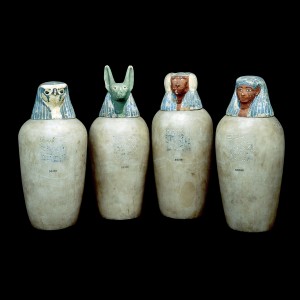
The first example of a grave good in Egyptian funerary practices occurred before 1000 B.C. in little jars called “Canoptic jars”. We will be looking at the Canoptic jars from Deir el-Bahari (Upper Egypt) from the 21st Dynasty dating back to 1069-945 BCE. In the specific Canoptic jars that we are looking at, the jars contained the organs of a woman called ‘Neskhons’. These jars were notably special in the mummification process. The ritual of mummification is conspicuously expansive and intricate. Mummification includes the removal of internal organs from the deceased body and placed in these jars for preservation. The jars represent the ‘four sons of Horus’ and each jar protected a specific organ. Imsety (human-headed jar) protected the liver and is protected by Isis the goddess of creation, destruction, motherhood, magic, and fertility. Hapy (baboon- headed jar) protected the lungs and was protected by Nephthys the Goddess of households, death, service, and night. Finally, Qebehsenuef (falcon-headed jar) protected the intestines and Duametuf (jackal-headed jar) protected the stomach. But the organs were not simply taken from the body and put into these jars; they went through a process called embalming. This process consists of drying the body with a salt called natron and after they would rub oils onto the skin then wrap it in linen strips. But the organs were just washed, dried with natron and then wrapped in linen, skipping the oil part of the ritual. The whole mummification and embalming process did not just occur to the common or lower class at the time in Egyptian society. During the 21st Dynasty, only the upper class was able to have their bodies preserved and mummified in this fashion due to the limited amount of skilled embalmers and the economic weight it held. So through these funerary practices we are able to tell the socio-economic status of the body without knowing who the body really is. But as we discussed earlier, we know that the Canoptic jars we are examining are those of ‘Neskons’. Neskons had been born into the upper class where her father, Smendes II, who was the preist king of Amun on the Thebes wed her to blood uncle Penodjem II, who was also a high priest of Amun on the Thebes during the 21st Dynasty. In the Egyptian civilization, priests were seen as part of the upper class, and hence Neskhons was too. But these jars do not only provide true evidence of socio-economic status but they provide a look at the Egyptian civilization as a whole and what they deem as important. Death was not seen as the end of their life or soul, but more as a transitional state of waiting for revivification. The afterlife for the Egyptians was very difficult and often included jumping over many hurdles to get to the “last judgment” before entering the vast and everlasting afterlife. The Egyptians placed such importance on the mummification process because while the spirit of the deceased moved onto the afterlife, the body had to be preserved into order to venture into the afterlife as well. The reason the vital organs are taken out of the body and placed in these Canoptic jars is because the Egyptians did not believe they were needed during the journey into the afterlife, but were needed once they reached the afterlife. After about 1000 B.C. the mummification process eventually underwent a slight change and the organs were removed, dried and then placed back inside the body. But the Canoptic jars were still placed with the body whether they were fake or solid. The reason is to still present the protection of the four sons of Horus.

Another popular funerary practice common to Egyptian culture was the funerary mask. One of the most popular funerary masks is the “Mask of Tutankhamun” from the 18th dynasty around 1327 BCE, who we will be looking at in this exhibition. In order to understand the funerary mask we must dig into Pharaoh Tutankhamun biography (also known as king Tut). In relevance to other Egyptian kings, King Tut was a relatively minor king is the big scheme of things. His birth name, Sa Ra meaning “son of the sun” was later changed to Tutankhaen meaning “the living image of Aten”. Aten represents the god or spirit of the sun and is depicted as the actual solar disk. Tut belonged to the 18th Dynasty of Egyptian Kings, which existed during the period of the New Kingdom. In 1334 B.C. Tut was made Pharaoh at the age of 9 and that same year he married his half sister, Anhensenpaaten. But Tut’s rule only lasted a total of 9 years before his mysterious death at the age of 18/19. So why is King Tutankhamun so popular in todays society? In 1922, an archeologist named Howard Carter (with sponsor Lord Carnarvon) happened upon it and in its glory and wealth became an immediate fascination. Now that you know the background of Tutankhamun we can fully understand the funerary mask and the key elements that were put into producing this masterpiece. Funerary masks of this time were only produced for royalty, and it was not until later that they were manufactured for the elite classes of both male and female. The function of presenting the mask in solid gold not only represents the socio-economic status, that King Tut of course had, but it more importantly represents the immortal flesh of the pharaoh shining like the sun of a god. The lapis lazuli (blue part of mask) and glittering flesh represent the sun god, Horus. An important aspect of all mummification processes is due to the great book called “The Book of the Dead”. The Book of the Dead in short constitutes the spells and formulas for the use of the deceased in the afterlife and is contributed with the basic ideas of Egyptian mythology. Spell 151 is a visual compilation describing the mummification process and more closely the embalming ritual. This relates to funerary masks because the Book of the Dead explains how the special features of the mask such as the eyebrows, forehead, eyes, and other features delineate back to special divinities such as the four children of Horus (Imsety, Hapy, Qebehsenuef, and Duametuf). The Egyptians paid such close attention to detail to the masks because the masks were the physical representation of the dead and they also served as reassurance that the dead would arrive safely in the afterlife. The closer the mask looked to a true divinity, the better chances it has of afterlife. Upon arriving in the afterlife, they must gain acceptance among all other divinities in a council like structure and predominately Osiris, the great god of the dead. The function of covering the face of the mummy with a funerary mask in Egyptian culture demonstrates the journey and transition of the physical and spiritual state from this world and into the divine transformation afterlife. While King Tutankhamun might have gained popularity today through the sheer aesthetic beauty of his funerary mask, funerary masks are not only made to look pretty, but to more importantly serve as protection for the head during the mummification process. As we discussed with the Canoptic jars, this provides another example of how Egyptians placed great importance in preserving the deceased for afterlife.
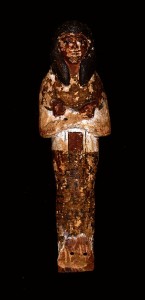
Our final piece of Egyptian art that we will be looking at in this exhibition is the Ushabti. The Ushabtis are little mummified figurines that were usually between ten and thirty centimeters tall and were made out of various materials. The function of these little figurines has changed throughout time. The example presented above is from the 26th Dynasty (663-525 B.C.E) and functions as a worker in the afterworld in place of the deceased, this is represented by on the back of these figurines where you will see a seed pouch wrapped across his body and tools to work in the afterworld, usually tools to sow and reap fields or depending on what action they will perform in the afterlife. But to really understand the reason for why the function of these little figurines have changed, we have to go back and look at the entire Egyptian civilization. The idea of the Ushabati dates back to the Predynastic (prior to 3100 B.C.), and Early Dynastic Period (3100-2686 B.C.), where actual human servants were to be sacrificed and buried with their deceased ruler. Luckily for the servants of later generations, this practice was deemed unnecessary and wasteful and that’s when the idea of a symbolic image of servants was invented. The first representation of a servant in Egyptian funerary practices is seen painted inside tombs and to function as aid for the deceased in the afterworld. This funerary trend eventually led to the idea of a tangible, small statue of a slave that was called “Shabti”. The Shabti is a small figure humanized to perform tasks for the deceased in the afterlife. In Egyptian afterlife, the sun god “Ra” provides each deceased person with a parcel of land so that the blessed dead could receive food in the afterlife.Like in Egyptian society, the wealthy and royalty did not perform manual labor during their life and they were not about to start now in the afterlife. Hence the function of the Shabti; they were given tools to complete the various agricultural tasks. Later the Shabti figure developed into either “Shawabti” or “Ushabti” depending on the time period and location. These figurines became more advanced in their overall appearance and their function, which was now inscribed on the tangible statue that clearly stated their job in the afterlife. The Shawabti figurines existed along the west bank of and Thebes during the 17th Dynasty(1580-1550 B.C.) and 18th Dynasty (1543-1292 B.C.). The Ushabati models existed from the 21st Dynasty and later on. Which brings us back to our example of the Ushabti figurine from the 26th Dynasty. Since our Ushabti figure is from after the Pre Dynastic period, there is an inscription on the small figurine that reads:
“The shining forth of the Osiris, General Ankh-wah-ib-Ra-sa-Neit. Child of (name unclear). Ushabti, if it is decreed that Osiris is to do work any there is in the afterlife, cast down the obstacles in front of this man. Behold me (whenever) you (the Ushabti) are called. Be watchfull at any moment to work there. To plough the fields, to water and (carry) the sand to the east, to the west. Behold me whenever called
Ultimately the inscription is stating that the Ushbati must plough the fields, water and or carry the sand to the east and west whenever Osiris calls upon on it. Like the Egyptian funerary practices that we discussed earlier, we know that the depictions of the deceased were highly stylized. The Ushabtis are another example of how the Egyptian civilization placed great importance on the preservation of the deceased and their transcending appearance into the afterlife. These tiny stylized figures depict the traditional Egyptian mummification body stance with the deceased arms crossed holding an Egyptian artifact.
Greeks
Moving onto our next civilization, The Greeks ruled from 8000 BCE to 30 BCE. During this period there were many small periods that characterized the current society and traditions. The Greeks viewed funerary rituals as a way to help the soul of the dead transcends into the next world. While they are transcending, the funerary rituals are there to help protect the deceased from bad luck and misfortune. The Greeks believed that when the person died, at that moment the psyche, or spirit of the dead, left the body like a little puff of wind. At this time is when the body was prepared for burial (whatever the ritual was for the time period). Ancient Greeks introduced the idea of related sleep and death; they have a saying “Sleep and death are brothers”. This idea of sleep and death interrelated is prevalent in ancient Greek funerary artwork which we will look at in this exhibition. Just like the Egyptians, the Greeks also placed grave goods in the honorable dead tombs consisting of weapons, jewelry, and other precious goods.
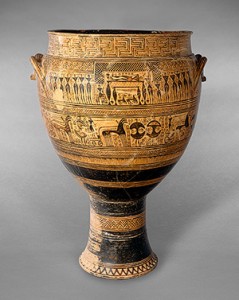
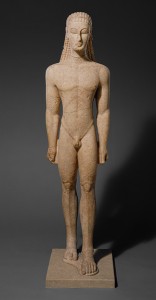
Etruscans
An example of the changing views of funerary practices is during the Etruscan period dating from about 750 BCE- 250 BCE. Like the other civilizations during this time there was a heavy emphasis on the afterlife. Talking about the Etruscan civilization, the Etruscans occupied the Northern territory of Italy while the Romans and Greeks were father south and we will examine how those civilizations intermingle with each other.

Compared to what we discussed earlier about the Greek civilization, the Etruscans were a completely different civilization, which we will be looking at today. Unlike the Greeks, a single leader or large city did not dominate the Etruscan culture. One aspect of Etruscan civilization that did dominant culture and everyday life was religion. In the Etruscan religion, their gods spoke to them (the mortals) through nature and natural events or disasters. With an obsession with religion there is a correlation that they would be extremely interested in the afterlife aspect of religion as well. The Etruscans believed that death was only the beginning and was the journey to the afterlife. Through the use of art and funerary practices, the Etruscans believed that the dead would not haunt mortals if they were pleased with their offerings to the afterlife. The example we will be looking at today is the Tomb of the Triclinium. From Tarquinia, Italy around 480-470 BCE. To fully understand the importance of the tomb, lets review how the city of Tarquinia impacts the Etruscan culture. Tarquinia is located on the west coast of the Italian peninsula and is best known as being one of the most authoritative and prominent centers in Italy of that time. The frescos upon the walls have scenes of dancers and people enjoying a classical party of the society. Hence why the frescos upon the walls are commonly referred to as “Dancers and Diners” and represent a celebratory funerary process. The partygoers represented in the frescoes are seen as reclining on “Trinclinium”, which are formal dining room couches in which you lounge in when you eat or relax. Servants are also waiting on the people while live music is being performed. The frescoes could represent either the daily life of the Etruscan culture or the way they want to live their afterlife. The people presented in the frescos are seen as either in pairs or alone but everyone is having a feast and viewed as having a good time at this celebration. The way they are celebrating, through the drinks and landscape, it is very extravagant and stylized. Breaking down the meaning of this tomb, we are first going to look at the most basic function of the tomb. The tomb is an ancient Etruscan funerary practice that involves a rock-cut tomb that contains the deceased and grave goods for the afterlife. The frescoes on the wall, unlike any civilization we have looked at in this exhibition, are not seen as somber but rather as a festival or a feast. The banquet aspect represents the transitional period from the living world to the afterlife in Etruscan funerary rituals. The deceased spirit is represented as the meal and the utensils and dishes are included in part of the grave goods. But it also serves to represent the social norms of the society. As we were talking about earlier, the Etruscans believed that in order to successfully pass into the afterlife, the deceased must be pleased with how their tomb is decorated; otherwise the dead will haunt the mortals. That is why the Etruscan spent so much time building and perfecting their tomb and rituals for the deceased. But the tomb also held grave goods or offerings for the dead to take into the afterlife. The frescoes on the wall also represent a stylistic similarity with the Greeks. By the similarities, we are able to deduct that the Greeks and Etruscans participated in trade that reveals history of the civilization. This example presents the way the Etruscan civilization viewed the death (or deaths) of a person of great importance or of high society and how the funerary norms are incorporated.
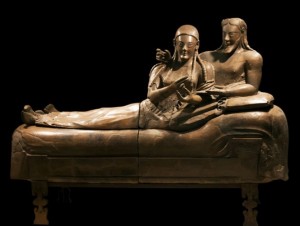
One of the most important Etruscan funerary artwork found to date is what we will be looking at today. The artwork is called the “sarcophagus of a married couple (or spouses)” around 520 BCE and is made out of terracotta. To fully understand the importance of this piece of art, lets look at the Etruscan civilizations history. The home of the Etruscans was located north of Rome. The Romans were not yet a full-fledged dominance in Italy and of the world yet but rather opposite of what we know it to be today. Until 509 BCE, Rome was still ruled by Etruscan kings. The artwork that we are looking at dates a little before the Romans dismissed the last Etruscan king in Rome. The sarcophagus is rather revolutionary compared to artworks during this time period. As we looked at earlier, the Kouros figure represents the differences in the two civilizations. Compared to the Greeks, the Kouros figure is presented as stiff looking and rigid. In this example, the couple is seen as being dynamic and as if they are moving into your space. Another radicle difference between this funerary representation and the Greeks is the incorporation of including the wife and husband together on the sarcophagus in a very intimate pose. On the other hand, the kouros figure stands alone and just represents the male. The incorporation of a female figure does more than just represent his wife. This proves that the Etruscan civilization viewed men and women as equals. Now lets look at the actual sarcophagus. The figures on the sarcophagus are of a husband and wife indulging at a banquet. Banquets were common scenes that were usually depicted in Etruscan tombs, like another earlier example we examined called the “Tomb of Triclinium”. But there are a few speculations about what the wife would have been holding. Either she is holding a cup or a glass, which would represent her function at a banquet. But on the other hand, some scholars believe that she may have been participating in an Etruscan funerary ritual. In this ritual, the wife is depicted as pouring perfume onto the husbands’ hand while he is holding a pomegranate (which was a symbol for immortality or the eternal) Like the other two civilizations we have investigated today, the Etruscans also idealized their deceased to an extent. Most aspects of the sarcophagus are stylized; from the cushions that they recline on to their hairstyles. The elongated proportions on the couples are typical of archaic stylized forms. Lets now examine the funerary aspects of this piece of art. The funerary function of the sarcophagus is rather misleading. Unlike ancient Egyptian sarcophagus’s that held the mummified body of the deceased, this sarcophagus did not actually hold the deceased physical bodies. Instead is held the cremated remains of the couple like an urn. In Etruscan funerary rituals, it was typical for the bodies of the dead to be cremated. The couple is presented as enjoying themselves at a banquet because the Etruscans believed that depicting the deceased how they want to be remembered in the afterlife would promise them eternal happiness. In the fear that they did not like their tomb, the ancient Etruscan funerary belief was that if the deceased was not pleased with their tomb they would haunt the mortals for eternity. That is why such great emphasis was put on the funerary aspects on the dead. This piece of art represents the Etruscan civilization and its funerary practices through the use of grave goods. The sarcophagus ultimately reveals the cultural norms of the elite and the funerary belief that death is a positive and celebratory occasion.
In the end, we reviewed three civilizations that represent the changing funerary practices in ancient societies. While some of these aspects are still prevalent in different cultures today, lets be grateful that most of these funerary practices and rituals are no longer prevalent!
Jessica Honeycutt
Work Cited
1- British Museum. “Canoptic Jars.” Mummification Explore. Accessed April 22, 2015.
2- “Tour Egypt :: Funerary and Other Masks of Ancient Egypt.” Funerary and Other Masks of Ancient Egypt. Accessed April 24, 2015. http://www.touregypt.net/featurestories/masks.htm.
3- “Heilbrunn Timeline of Art History.” Attributed to the Hirschfeld Workshop: Krater [Greek, Attic] (14.130.14). Accessed April 24, 2015. http://www.metmuseum.org/toah/works-of-art/14.130.14.
4- “Interpretive Resource.” Interpretive Resource. Accessed April 24, 2015. http://www.artic.edu/aic/resources/resource/2663.
5- “Art History Lab.” Brian Wildeman’s Art History Lab Etruscan. Accessed April 24, 2015. http://people.ucls.uchicago.edu/~bwildem/art_hist_laba/etruscan/sarcophagus.html